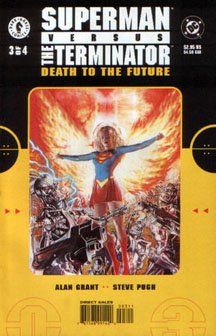Writer Alan Grant started his 13-issue run on “The Terminator” with the gritty, adult-oriented “Death Valley,” then followed it up with the shallow “The Dark Years,” and he closes on an even weaker note with the kiddie-oriented “Superman versus The Terminator: Death to the Future”(2000). I wasn’t a “Superman” fan to begin with, but this four-issue series does nothing to pique my interest in that saga, and it also treats the “Terminator” concept shallowly.
“Death Valley” introduces a teenage John and 30-something Sarah at the turn of the century on a timeline without “T2” and without a Judgment Day so far. It sets up fresh possibilities. But Grant ended up doing nothing with those possibilities, as Sarah and John (with the exception of Future John) remain in victim mode throughout Grant’s saga. And I can’t imagine “Superman” fans find the portrayals of Supes and his colleagues anything other than rote in this series.
CHARACTERS
John Connor: He killed his first Terminator (on this timeline) in “The Dark Years” a year earlier, but now he’s back in victim mode.
Sarah Connor: Also in victim mode, she spends most of “SvT” worrying about John’s safety.
Kyle Reese: Dead for 16 years, and 10 years from being born. Not present in the 2032-set scenes.
“Superman” characters: Superman, Supergirl, Superboy, Lois Lane and Lex Luthor fight the Terminators in Metropolis in 2000, while Steel (and later in the narrative, Superman) does so in 2032.
TERMINATORS
T-800s and endoskeletons: Skynet sends a bevy of these to Metropolis in 2000, first to kill Sarah and John and then to distract Supergirl and Superboy.
Terminator with eye beams: The first Terminator that pursues the Connors in Metropolis shoots eye-beams like Cyclops from “The X-Men.”
Terminatrix: Three years before “T3” came out and formally introduced the Terminatrix to the big screen, “SvT” introduces a character by this name who specifically stalks John. She doesn’t have any of the T-X’s attributes, though, and seems to be a T-800.
Sky-1: In the 2032 scenes, Skynet embodies all of its power into one robot so that it may more easily taunt Superman and Steel. But it also makes it easier for Superman and Steel to defeat it.
Cyborg: Not technically a Terminator, but he’s a human with tons of machine parts who blames Superman for turning him into a freak. In a way, he’s the Terminator of the “Superman”-verse.
CONTINUITY
The “present-day” scenes pick up from “The Dark Years” and are set in 2000 in Metropolis. The Future War scenes are set in 2032 in Metropolis, likewise picking up from “The Dark Years.”
In the Future War, Steel and Superman encounter “skells,” the resistance’s term for cannibals (perhaps based on “skeleton?”). In the Now Comics, the resistance encounters “scavs” (presumably short for “scavengers”). In both cases, these are groups of humans who do not work for the resistance – a concept that has arguably been underexplored up to this point.

Sky-1 introduces a new term that has a nice simplicity similar to “Judgment Day”: “Omega Point.” This is the point at which all humans are dead. The resistance aims for its own Omega Point: the point at which Skynet is dead.
When Steel “reels back” Superman from 2000 to 2032 in his failed attempt to snatch a Terminator, it marks the second example of forward time travel in the “Terminator” saga, the first being RoboCop’s fast-forward through time via Skynet in “RoboCop versus The Terminator.” The most famous examples of forward time travel in the franchise will occur in “The Sarah Connor Chronicles.”
Incidentally, when Superman gets displaced from 2000 to 2032, he is not harmed by the fact that he is clothed and not covered in conductive gel. While the saga has been inconsistent about the gel, it had been consistent about the time-travelers needing to be naked. Superman, however, suffers no harm; his clothes simply disappear. Then again, because he is the Man of Steel, we probably shouldn’t extrapolate rules to include normal humans. Additionally, he is not technically the time traveler; he’s being displaced in the other direction.
TIME TRAVEL
Skynet and even the good guys heavily manipulate the timeline(s) in “SvT,” making this a story where the future most definitely is not set. As such, pretty much everything falls under that category in our evidence tally.
Throughout these timeline manipulations, “SvT” provides a lot of credence for the multiple-timelines theory, although most of the dialog and narration still refers to the one-true-timeline model that “Terminator” yarns generally adhere to. On the other hand, in previous stories Dark Horse has embraced the multiple-timelines theory outright, from the birth of Jane Connor in “End Game” to the erasure of the “T2” events in Grant’s stories. So one could make a case that “SvT” adds more fuel to that fire, regardless of how the characters speak about time.
Evidence for “fate”:
- As always, John is the resistance leader in the future, even though this story does not show him developing any leadership skills as a teen.
- It seems Skynet will eventually be born, even if it takes Lex Luthor to do so. He has been studying Skynet tech for some time – it’s why his company is able to quickly develop a virus to stop the Terminators’ 2000 incursion. At the story’s end, he aims to build – and more importantly, control – Skynet.
Evidence that “the future” – and the past and present, for that matter – “is not set”:
- Although Sarah believes Skynet will be created and gain sentience “not very far in our future,” it still hasn’t happened by 2000, three years after the 1997 date we were familiar with before “T3” came out. (Because this is the “Terminator”-only timeline and not the “T2” timeline, Sarah does not know about the 1997 date.) In a similar changing of dates, the resistance defeats Skynet in 2032 in this yarn, whereas 2029 is the traditional year of Skynet’s defeat. (As I noted in my “Dark Years” write-up, it’s unclear if John sends Kyle back from 2029 to 1984 in this timeline. He probably does. But if he doesn’t, it’s strong evidence that the future is not set if John isn’t required by the time gods to send Kyle back.)
- Cyborg “arms the future with information to defeat Superman” by storing the information in an endoskeleton skull it hopes Skynet will discover in the future. Since Cyborg hasn’t already seen Skynet use that information in the 2000 Metropolis battle, which would be a fateful event, he believes the timeline (not only the future, but also the past and present) is not set. And it seems he’s correct.
- The resistance, including John and Superman’s pal Steel, commandeers a TDE platform and “trie(s) to reel the robot back.” But instead of grabbing the Terminator, it transplants Superman from 2000 to 2032.
- As always, Future John isn’t totally confident about how time travel works. For example, he thinks “Just one thing troubles me: I only remember Superman saving me once.” John knows time can be in a state of flux, but he isn’t sure what that entails. Still, he seems to lean toward the idea of multiple timelines. In the wake of the resistance’s victory over Skynet, he tells Superman: “The future belongs to mankind, but the horror can still happen again. And you can bet Skynet won’t make the same mistakes the next time around.” Then he sends Superman back to 2000 to fight the Terminators in Metropolis. It seems John is saying: “The future (of me and my friends on this timeline) belongs to mankind, but the horror can still happen again (on another timeline, which also includes a version of me and versions of other people I care about).”
- Supergirl notes that the Terminators have “new features with each wave that arrives,” strongly suggesting that Skynet is learning new ways to win this fight on each pass through the timeline.
- Superman seems to lean toward the one-timeline-that-can-be-changed model, but hedges his bets by using the plural: “If they succeed, it’ll change the timelines again!” Illustrating Supes’ confusion, that sentence makes no logical sense. While a timeline can be changed if there is only one true timeline, a plurality of timelines simply means new timelines are created, not that old ones are changed.

